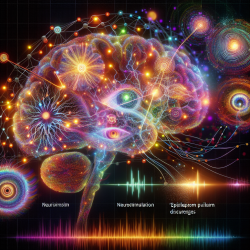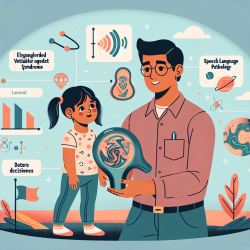Introduction
In the ever-evolving field of speech-language pathology and neurotherapy, data-driven decisions are paramount. A recent study titled "Multisensory flicker modulates widespread brain networks and reduces interictal epileptiform discharges" offers promising insights into how multisensory flicker can be used to modulate brain networks and reduce pathological neural activity. This blog post aims to elucidate the potential applications of these findings in clinical settings, particularly for practitioners focused on improving outcomes for children with neurological disorders.
The Study: Key Findings
The study, published in Nature Communications, explores the effects of multisensory flicker—specifically repetitive audio-visual stimulation—on brain activity. Conducted with patients undergoing intracranial seizure monitoring, the research demonstrated that flicker could modulate local field potentials in sensory cortices and cognitive regions such as the medial temporal lobe and prefrontal cortex. Notably, flicker exposure decreased interictal epileptiform discharges (IEDs), a pathological marker associated with epilepsy and other degenerative diseases.
Implications for Practitioners
For speech-language pathologists and neurotherapists, these findings offer a non-invasive method to potentially enhance therapeutic outcomes. Here are some practical applications:
- Integrating Multisensory Flicker: Practitioners can explore incorporating multisensory flicker into therapy sessions, particularly for children with epilepsy or cognitive impairments. The non-invasive nature of flicker makes it suitable for chronic daily use, potentially enhancing therapeutic efficacy.
- Targeted Interventions: The study highlights the ability of flicker to modulate specific brain regions. Practitioners can tailor interventions to target areas implicated in a child's specific condition, such as the medial temporal lobe for memory-related issues.
- Reducing Epileptiform Activity: By decreasing IEDs, multisensory flicker may reduce cognitive impairments associated with epilepsy, thereby improving a child's overall cognitive function and quality of life.
Encouraging Further Research
While the study provides a solid foundation, further research is necessary to fully understand the mechanisms and optimize the use of multisensory flicker in therapeutic settings. Practitioners are encouraged to participate in or initiate research studies to explore the broader applications of flicker across different populations and neurological conditions.
Conclusion
Multisensory flicker presents a promising avenue for non-invasive neurostimulation, with the potential to modulate brain networks and reduce pathological neural activity. For practitioners dedicated to improving outcomes for children, integrating such innovative approaches could significantly enhance therapeutic efficacy. As we continue to unravel the complexities of the brain, data-driven interventions like multisensory flicker will play a crucial role in shaping the future of neurotherapy.
To read the original research paper, please follow this link: Multisensory flicker modulates widespread brain networks and reduces interictal epileptiform discharges.










